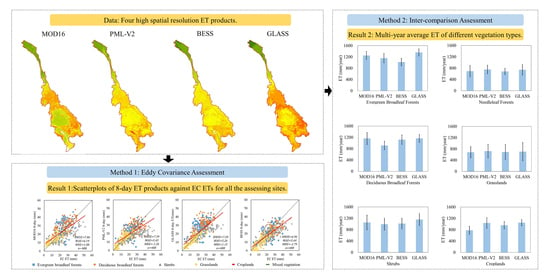Assessment and Inter-Comparison of Multi-Source High Spatial Resolution Evapotranspiration Products over Lancang–Mekong River Basin, Southeast Asia
Abstract
1. Introduction
2. Materials and Methods
2.1. Study Area
2.2. Data
2.2.1. Land Cover Data
2.2.2. Remote Sensing Evapotranspiration Products
- MOD16
- 2.
- PML-V2
- 3.
- BESS
- 4.
- GLASS
2.2.3. Eddy Covariance ET
2.3. Methods
2.3.1. Validation
2.3.2. Inter-Comparison of the Four ET Products
2.3.3. Comparison with Studies from the Same Climates
3. Results
3.1. Performance Assessment Based on Eddy Covariance
3.2. Performance Based on Inter-Comparison
3.3. Performance Based on Literature Comparison
4. Discussion
4.1. Possible Reasons for the Inconsistent Performance of the Four Products
4.1.1. Inconsistency of Model Inputs
4.1.2. Inconsistency of Model Structures
4.2. Uncertainties in Assessment Method
4.3. Future Directions
5. Conclusions
Author Contributions
Funding
Data Availability Statement
Acknowledgments
Conflicts of Interest
Appendix A
| Code | Country | Vegetation Type | Locations | ET (mm/Year) | Period | Köppen Climate 1 | Modified Climate Zone Used in This Study |
|---|---|---|---|---|---|---|---|
| 1 | Cambodia | EBF | 12°44′N, 105°28′E | 1140 | 2003–2004 | Aw | Equatorial |
| 2 | Malaysia | EBF | 4°12′N, 114°02′E | 1545 | 2001–2002 | Af | Equatorial |
| 3 | Malaysia | EBF | 2°58′N, 102°18′E | 1287 | 2003–2010 | Af | Equatorial |
| 4 | Cambodia | EBF | 12°44′N, 105°28′E | 1140 | 2004 | Aw | Equatorial |
| 5 | Thailand | EBF | 18°25′N, 99°43′E | 977 | 2007–2009 | Aw | Equatorial |
| 6 | Vietnam | EBF | 11°27′N, 107°24′E | 1519 | 2011–2017 | Aw | Equatorial |
| 7 | China | DBF | 41°59′N, 101°07′E | 653.4 | 2014 | BWk | Warm |
| 8 | China | DBF | 29°31′N, 112°55′E | 1033 | 2010–2012 | Cfa | Warm |
| 9 | China | DBF | 35°01′N, 112°28′E | 579 | 2006–2010 | Cwa | Warm |
| 10 | China | DBF | 39°32′N, 116°16′E | 571 | 2006–2009 | Cwa | Warm |
| 11 | Indonesia | Cropland | 1°08′S, 102°50′E | 1058 | 2001–2003 | Af | Equatorial |
| 12 | Brazil | Cropland | 29°45′S, 53°9′W | 998 | 2003–2004 | Cfa | Warm |
| 13 | Bangladesh | Cropland | 24°44′N, 90°25′E | 997 | 2007 | Am | Equatorial |
| 14 | China | Cropland | 28°26′N, 116°00′E | 1174 | 2016–2017 | Cfa | Warm |
| 15 | Philippines | Cropland | 14°8′N, 121°16′E | 1441 | 2008–2009 | Af | Equatorial |
| 16 | Japan | Cropland | 36°03′N, 140°01′E | 956 | 2005 | Cfa | Warm |
| 17 | Brazil | Shrub | 15°56′S, 47°53′W | 1060 | 2001–2003 | Aw | Equatorial |
| 18 | Australia | Shrub | 12°30′S, 130°45′E | 958 | 1996–1998 | Aw | Equatorial |
| 19 | Venezuela | Shrub | - 2 | 732 | 2000–2001 | Aw | Equatorial |
| 20 | Venezuela | Shrub | - 2 | 771 | 2000–2001 | Aw | Equatorial |
| 21 | Brazil | Shrub | 15°56′S, 47°57′W | 840 | 2001–2002 | Aw | Equatorial |
| 22 | Venezuela | Shrub | - 2 | 538 | 1999–2000 | Aw | Equatorial |
| 23 | Venezuela | Shrub | - 2 | 721 | 1999–2000 | Aw | Equatorial |
| 24 | Mongolia | Grassland | 47°45′N, 107°20′E | 176.95 | 2003–2004 | Dwc | Snow and polar |
| 25 | China | Grassland | 33°53′N, 102°08′E | 580 | 2010 | Dwb | Snow and polar |
| 26 | China | Grassland | 27°10′N, 100°14′E | 434 | 2012–2013 | Cwb | Warm |
| 27 | China | Grassland | 35°57′N, 104°08′E | 386 | 2007–2012 | Dwb | Snow and polar |
| 28 | China | Grassland | 38°03′N, 100°28′E | 556.6 | 2013–2015 | ET | Snow and polar |
| 29 | China | Grassland | 38°25′N, 98°19′E | 270.6 | 2011 | ET | Snow and polar |
| 30 | China | Grassland | 37°36′N, 101°18′E | 390 | 2002–2005 | BSk | Warm |
| 31 | China | Grassland | 31°39′N, 92°01′E | 417 | 2014/2017 | ET | Snow and polar |
| 32 | China | Grassland | 34°24′N, 100°24′E | 505.65 | 2007–2008 | Dwc | Snow and polar |
| 33 | China | Grassland | 37°40′N, 101°20′E | 420.2 | 2002–2005 | BSk | Warm |
| 34 | China | Grassland | 30°51′N, 91°05′E | 495.55 | 2004–2005 | ET | Snow and polar |
| 35 | China | NF 3 | 26°44′N, 115°03′E | 787 | 2003–2010 | Cfa | Warm |
| 36 | Japan | NF 3 | 34°58′N, 136°00′E | 752 | 2001–2007 | Cfa | Warm |
| 37 | Japan | NF 3 | 42°44′N, 141°31′E | 494 | 2002–2003 | Dfb | Snow and polar |
| 38 | China | MV | 40°22′N, 115°56′E | 580.75 | 2006–2009 | Dwb | Snow and polar |
| 39 | China | MV | 42°24′N, 128°05′E | 525 | 2005–2007 | Dwb | Snow and polar |
References
- Oki, T.; Kanae, S. Global hydrological cycles and world water resources. Science 2006, 313, 1068–1072. [Google Scholar] [CrossRef]
- Lettenmaier, D.P.; Famiglietti, J.S. Hydrology-Water from on high. Nature 2006, 444, 562–563. [Google Scholar] [CrossRef]
- Jung, M.; Reichstein, M.; Ciais, P.; Seneviratne, S.I.; Sheffield, J.; Goulden, M.L.; Bonan, G.; Cescatti, A.; Chen, J.; de Jeu, R.; et al. Recent decline in the global land evapotranspiration trend due to limited moisture supply. Nature 2010, 467, 951–954. [Google Scholar] [CrossRef] [PubMed]
- Michel, D.; Jiménez, C.; Miralles, D.G.; Jung, M.; Hirschi, M.; Ershadi, A.; Martens, B.; McCabe, M.F.; Fisher, J.B.; Mu, Q.; et al. The WACMOS-ET project–Part 1: Tower-scale evaluation of four remote-sensing-based evapotranspiration algorithms. Hydrol. Earth Syst. Sci. 2016, 20, 803–822. [Google Scholar] [CrossRef]
- Allen, R.G.; Pereira, L.S.; Raes, D.; Smith, M. Crop Evapotranspiration-Guidelines for Computing Crop Water Requirements-FAO Irrigation and Drainage Paper 56; FAO: Rome, Italy, 1998; p. D05109. [Google Scholar]
- Raoufi, R.; Beighley, E. Estimating daily global evapotranspiration using Penman–Monteith equation and remotely sensed land surface temperature. Remote Sens. 2017, 9, 1138. [Google Scholar] [CrossRef]
- Gan, R.; Zhang, Y.; Shi, H.; Yang, Y.; Eamus, D.; Cheng, L.; Chiew, F.H.S.; Yu, Q. Use of satellite leaf area index estimating evapotranspiration and gross assimilation for Australian ecosystems. Ecohydrology 2018, 11, e1974. [Google Scholar] [CrossRef]
- Chen, Y.; Wang, S.; Ren, Z.; Huang, J.; Wang, X.; Liu, S.; Deng, H.; Lin, W. Increased evapotranspiration from land cover changes intensified water crisis in an arid river basin in northwest China. J. Hydrol. 2019, 574, 383–397. [Google Scholar] [CrossRef]
- Zhang, Y.; Kong, D.; Gan, R.; Chiew, F.H.S.; McVicar, T.R.; Zhang, Q.; Yang, Y. Coupled estimation of 500 m and 8-day resolution global evapotranspiration and gross primary production in 2002–2017. Remote Sens. Environ. 2019, 222, 165–182. [Google Scholar] [CrossRef]
- Yuan, L.; Ma, Y.; Chen, X.; Wang, Y.; Li, Z. An enhanced MOD16 evapotranspiration model for the Tibetan Plateau during the unfrozen season. J. Geophys. Res. Atmos. 2021, 126, e2020JD032787. [Google Scholar] [CrossRef]
- Mu, Q.; Zhao, M.; Running, S.W. Improvements to a MODIS global terrestrial evapotranspiration algorithm. Remote Sens. Environ. 2011, 115, 1781–1800. [Google Scholar] [CrossRef]
- Zhang, Y.; Peña-Arancibia, J.L.; McVicar, T.R.; Chiew, F.H.S.; Vaze, J.; Liu, C.; Lu, X.; Zheng, H.; Wang, Y.; Liu, Y.Y.; et al. Multi-decadal trends in global terrestrial evapotranspiration and its components. Sci. Rep. 2016, 6, 19124. [Google Scholar] [CrossRef] [PubMed]
- Li, X.; He, Y.; Zeng, Z.; Lian, X.; Wang, X.; Du, M.; Jia, G.; Li, Y.; Ma, Y.; Tang, Y.; et al. Spatiotemporal pattern of terrestrial evapotranspiration in China during the past thirty years. Agric. For. Meteorol. 2018, 259, 131–140. [Google Scholar] [CrossRef]
- Li, Z.; Zhang, Y.; Wang, S.; Yuan, G.; Yang, Y.; Cao, M. Evapotranspiration of a tropical rain forest in Xishuangbanna, southwest China. Hydrol. Processes 2010, 24, 2405–2416. [Google Scholar] [CrossRef]
- Thornthwaite, C.W.; Holzman, B. The determination of evaporation from land and water surfaces. Mon. Weather Rev. 1939, 67, 4–11. [Google Scholar] [CrossRef]
- Monteith, J.L. Evaporation and environment. Symp. Soc. Exp. Biol. 1965, 19, 205–234. [Google Scholar]
- Gentilucci, M.; Bufalini, M.; Materazzi, M.; Barbieri, M.; Aringoli, D.; Farabollini, P.; Pambianchi, G. Calculation of potential evapotranspiration and calibration of the Hargreaves Equation using geostatistical methods over the Last 10 Years in Central Italy. Geosciences 2021, 11, 348. [Google Scholar] [CrossRef]
- Yao, Y.; Liang, S.; Cheng, J.; Liu, S.; Fisher, J.B.; Zhang, X.; Jia, K.; Zhao, X.; Qin, Q.; Zhao, B.; et al. MODIS-driven estimation of terrestrial latent heat flux in China based on a modified Priestley–Taylor algorithm. Agric. For. Meteorol. 2013, 171–172, 187–202. [Google Scholar] [CrossRef]
- Priestley, C.; Taylor, R. On the assessment of surface heat flux and evaporation using large-scale parameters. Mon. Weather Rev. 1972, 100, 81–92. [Google Scholar] [CrossRef]
- Yang, Y.; Su, H.; Zhang, R.; Tian, J.; Li, L. An enhanced two-source evapotranspiration model for land (ETEML): Algorithm and evaluation. Remote Sens. Environ. 2015, 168, 54–65. [Google Scholar] [CrossRef]
- Tang, R.; Li, Z.-L.; Tang, B. An application of the T-s-VI triangle method with enhanced edges determination for evapotranspiration estimation from MODIS data in and and semi-arid regions: Implementation and validation. Remote Sens. Environ. 2010, 114, 540–551. [Google Scholar] [CrossRef]
- Zeng, Z.; Piao, S.; Lin, X.; Yin, G.; Peng, S.; Ciais, P.; Myneni, R.B. Global evapotranspiration over the past three decades: Estimation based on the water balance equation combined with empirical models. Environ. Res. Lett. 2012, 7, 014026. [Google Scholar] [CrossRef]
- Miralles, D.G.; Holmes, T.R.H.; De Jeu, R.A.M.; Gash, J.H.; Meesters, A.G.C.A.; Dolman, A.J. Global land-surface evaporation estimated from satellite-based observations. Hydrol. Earth Syst. Sci. 2011, 15, 453–469. [Google Scholar] [CrossRef]
- Martens, B.; Miralles, D.G.; Lievens, H.; van der Schalie, R.; de Jeu, R.A.M.; Fernández-Prieto, D.; Beck, H.E.; Dorigo, W.A.; Verhoest, N.E.C. GLEAM v3: Satellite-based land evaporation and root-zone soil moisture. Geosci. Model Dev. 2017, 10, 1903–1925. [Google Scholar] [CrossRef]
- Leuning, R.; Zhang, Y.; Rajaud, A.; Cleugh, H.; Tu, K. A simple surface conductance model to estimate regional evaporation using MODIS leaf area index and the Penman-Monteith equation. Water Resour. Res. 2008, 44. [Google Scholar] [CrossRef]
- Mu, Q.; Heinsch, F.A.; Zhao, M.; Running, S.W. Development of a global evapotranspiration algorithm based on MODIS and global meteorology data. Remote Sens. Environ. 2007, 111, 519–536. [Google Scholar] [CrossRef]
- Ryu, Y.; Baldocchi, D.D.; Kobayashi, H.; van Ingen, C.; Li, J.; Black, T.A.; Beringer, J.; van Gorsel, E.; Knohl, A.; Law, B.E.; et al. Integration of MODIS land and atmosphere products with a coupled-process model to estimate gross primary productivity and evapotranspiration from 1 km to global scales. Glob. Biogeochem. Cycle 2011, 25. [Google Scholar] [CrossRef]
- Yao, Y.; Liang, S.; Li, X.; Hong, Y.; Fisher, J.B.; Zhang, N.; Chen, J.; Cheng, J.; Zhao, S.; Zhang, X.; et al. Bayesian multimodel estimation of global terrestrial latent heat flux from eddy covariance, meteorological, and satellite observations. J. Geophys. Res.-Atmos. 2014, 119, 4521–4545. [Google Scholar] [CrossRef]
- Wu, J.; Lakshmi, V.; Wang, D.; Lin, P.; Pan, M.; Cai, X.; Wood, E.F.; Zeng, Z. The reliability of global remote sensing evapotranspiration products over Amazon. Remote Sens. 2020, 12, 2211. [Google Scholar] [CrossRef]
- Yin, L.; Wang, X.; Feng, X.; Fu, B.; Chen, Y. A comparison of SSEBop-Model-Based evapotranspiration with eight evapotranspiration products in the Yellow River Basin, China. Remote Sens. 2020, 12, 2528. [Google Scholar] [CrossRef]
- Liu, Y.; Yang, Z.; Lin, P.; Zheng, Z.; Xie, S. Comparison and evaluation of multiple land surface products for the water budget in the Yellow River Basin. J. Hydrol. 2020, 584, 124534. [Google Scholar] [CrossRef]
- Zheng, C.; Jia, L.; Hu, G.; Lu, J. Earth observations-based evapotranspiration in Northeastern Thailand. Remote Sens. 2019, 11, 138. [Google Scholar] [CrossRef]
- Jiang, C.; Ryu, Y. Multi-scale evaluation of global gross primary productivity and evapotranspiration products derived from Breathing Earth System Simulator (BESS). Remote Sens. Environ. 2016, 186, 528–547. [Google Scholar] [CrossRef]
- Li, S.; Wang, G.; Sun, S.; Chen, H.; Bai, P.; Zhou, S.; Huang, Y.; Wang, J.; Deng, P. Assessment of Multi-Source evapotranspiration products over China using eddy covariance observations. Remote Sens. 2018, 10, 1692. [Google Scholar] [CrossRef]
- Ershadi, A.; McCabe, M.F.; Evans, J.P.; Chaney, N.W.; Wood, E.F. Multi-site evaluation of terrestrial evaporation models using FLUXNET data. Agric. For. Meteorol. 2014, 187, 46–61. [Google Scholar] [CrossRef]
- Khan, M.S.; Liaqat, U.W.; Baik, J.; Choi, M. Stand-alone uncertainty characterization of GLEAM, GLDAS and MOD16 evapotranspiration products using an extended triple collocation approach. Agric. For. Meteorol. 2018, 252, 256–268. [Google Scholar] [CrossRef]
- Zhao, Y.; Lu, Z.; Wei, Y. An Assessment of Global Precipitation and Evapotranspiration Products for Regional Applications. Remote Sens. 2019, 11, 1077. [Google Scholar] [CrossRef]
- Wang, L.; Wu, B.; Elnashar, A.; Zeng, H.; Zhu, W.; Yan, N. Synthesizing a regional territorial evapotranspiration dataset for Northern China. Remote Sens. 2021, 13, 1076. [Google Scholar] [CrossRef]
- Yang, X.; Yong, B.; Ren, L.; Zhang, Y.; Long, D. Multi-scale validation of GLEAM evapotranspiration products over China via ChinaFLUX ET measurements. Int. J. Remote Sens. 2017, 38, 5688–5709. [Google Scholar] [CrossRef]
- Gao, X.; Gu, F.; Gong, D.; Hao, W.; Chu, J.; Li, H. Comparison of three evapotranspiration models in a rain-fed spring maize filed in the Loess Plateau, China. J. Agric. Meteorol. 2020, 76, 155–163. [Google Scholar] [CrossRef]
- Chu, H.; Luo, X.; Ouyang, Z.; Chan, W.S.; Dengel, S.; Biraud, S.C.; Torn, M.S.; Metzger, S.; Kumar, J.; Arain, M.A.; et al. Representativeness of Eddy-Covariance flux footprints for areas surrounding AmeriFlux sites. Agric. For. Meteorol. 2021, 301–302, 108350. [Google Scholar] [CrossRef]
- Sun, R.; Duan, Q.; Wang, J. Understanding the spatial patterns of evapotranspiration estimates from land surface models over China. J. Hydrol. 2021, 595, 126021. [Google Scholar] [CrossRef]
- Sriwongsitanon, N.; Suwawong, T.; Thianpopirug, S.; Williams, J.; Jia, L.; Bastiaanssen, W. Validation of seven global remotely sensed ET products across Thailand using water balance measurements and land use classifications. J. Hydrol. Reg. Stud. 2020, 30, 100709. [Google Scholar] [CrossRef]
- Yun, X.; Tang, Q.; Li, J.; Lu, H.; Zhang, L.; Chen, D. Can reservoir regulation mitigate future climate change induced hydrological extremes in the Lancang-Mekong River Basin? Sci. Total Environ. 2021, 785, 147322. [Google Scholar] [CrossRef]
- Wei, J.; Wei, Y.; Tian, F.; Nott, N.; de Wit, C.; Guo, L.; Lu, Y. News media coverage of conflict and cooperation dynamics of water events in the Lancang–Mekong River basin. Hydrol. Earth Syst. Sci. 2021, 25, 1603–1615. [Google Scholar] [CrossRef]
- Li, D.; Zhao, J.; Govindaraju, R.S. Water benefits sharing under transboundary cooperation in the Lancang-Mekong River Basin. J. Hydrol. 2019, 577, 123989. [Google Scholar] [CrossRef]
- Gao, J.; Zhao, J.; Wang, H. Dam-Impacted Water-Energy-Food Nexus in Lancang-Mekong River Basin. J. Water Resour. Plan. Manag. 2021, 147, 04021010. [Google Scholar] [CrossRef]
- Sulla-Menashe, D.; Gray, J.M.; Abercrombie, S.P.; Friedl, M.A. Hierarchical mapping of annual global land cover 2001 to present: The MODIS Collection 6 Land Cover product. Remote Sens. Environ. 2019, 222, 183–194. [Google Scholar] [CrossRef]
- Lahiri, S.N. Resampling methods for spatial data. In Resampling Methods for Dependent Data; Springer: New York, NY, USA, 2003; pp. 281–338. [Google Scholar]
- Gao, W. Applications of solutions to non-linear energy budget equations. Agric. For. Meteorol. 1988, 43, 121–145. [Google Scholar] [CrossRef]
- Yuan, W.; Liu, S.; Yu, G.; Bonnefond, J.-M.; Chen, J.; Davis, K.; Desai, A.R.; Goldstein, A.H.; Gianelle, D.; Rossi, F.; et al. Global estimates of evapotranspiration and gross primary production based on MODIS and global meteorology data. Remote Sens. Environ. 2010, 114, 1416–1431. [Google Scholar] [CrossRef]
- Fisher, J.B.; Tu, K.P.; Baldocchi, D.D. Global estimates of the land–atmosphere water flux based on monthly AVHRR and ISLSCP-II data, validated at 16 FLUXNET sites. Remote Sens. Environ. 2008, 112, 901–919. [Google Scholar] [CrossRef]
- Wang, K.; Dickinson, R.E.; Wild, M.; Liang, S. Evidence for decadal variation in global terrestrial evapotranspiration between 1982 and 2002: 2. Results. J. Geophys. Res.-Atmos. 2010, 115. [Google Scholar] [CrossRef]
- Kim, W.; Hyeongho, S.; Komori, D.; Jaeil, C. Characteristics of the relative sampling error and its application to flux aggregation in eddy covariance measurements. J. Agric. Meteorol. 2020, 76, 89–95. [Google Scholar] [CrossRef]
- Kim, W.; Miyata, A.; Ashraf, A.; Maruyama, A.; Chidthaisong, A.; Jaikaeo, C.; Komori, D.; Ikoma, E.; Sakurai, G.; Seoh, H.-H.; et al. FluxPro as a realtime monitoring and surveilling system for eddy covariance flux measurement. J. Agric. Meteorol. 2015, 71, 32–50. [Google Scholar] [CrossRef]
- Wohlfahrt, G.; Haslwanter, A.; Hörtnagl, L.; Jasoni, R.L.; Fenstermaker, L.F.; Arnone, J.A.; Hammerle, A. On the consequences of the energy imbalance for calculating surface conductance to water vapour. Agric. For. Meteorol. 2009, 149, 1556–1559. [Google Scholar] [CrossRef] [PubMed]
- Qi, D.; Yang, D.; Song, Q.; Liu, Y.; Zhang, Y.; Fei, X.; Sha, L.; Zhou, W.; Chen, A.; Wen, G.; et al. An observation dataset of carbon and water fluxes at Yuanjiang Dry-hot Valley Ecological Station (2013–2015). China Sci. Data 2021, 6, 110–122. [Google Scholar] [CrossRef]
- Qi, D.; Zhang, Y.; Song, Q.; Fei, X.; Sha, L.; Liu, Y.; Zhou, W.; Zhou, L.; Deng, X.; Luo, Y.; et al. A dataset of carbon, water and energy fluxes observed in Xishuangbanna tropical seasonal rain forest from 2003 to 2010. China Sci. Data 2021, 6, 37–49. [Google Scholar] [CrossRef]
- Qi, D.; Fei, X.; Song, Q.; Zhang, Y.; Sha, L.; Liu, Y.; Zhou, W.; Lu, Z.; Fan, Z. A dataset of carbon and water fluxes observation in subtropical evergreen broad-leaved forest in Ailao Shan from 2009 to 2013. China Sci. Data 2021, 6, 87–97. [Google Scholar] [CrossRef]
- Yu, H.; Qi, D.; Zhang, Y.; Sha, L.; Liu, Y.; Zhou, W.; Deng, Y.; Song, Q. An observation dataset of carbon and water fluxes in Xishuangbanna rubber plantations from 2010 to 2014. China Sci. Data 2021, 6, 98–109. [Google Scholar] [CrossRef]
- Gomis-Cebolla, J.; Jimenez, J.C.; Sobrino, J.A.; Corbari, C.; Mancini, M. Intercomparison of remote-sensing based evapotranspiration algorithms over amazonian forests. Int. J. Appl. Earth Obs. Geoinf. 2019, 80, 280–294. [Google Scholar] [CrossRef]
- Idso, S.B.; Jackson, R.D. Thermal radiation from the atmosphere. J. Geophys. Res. 1969, 74, 5397–5403. [Google Scholar] [CrossRef]
- Prata, A.J. A new long-wave formula for estimating downward clear-sky radiation at the surface. Q. J. R. Meteorol. Soc. 1996, 122, 1127–1151. [Google Scholar] [CrossRef]
- Obermeier, W.A.; Lehnert, L.W.; Kammann, C.I.; Müller, C.; Grünhage, L.; Luterbacher, J.; Erbs, M.; Moser, G.; Seibert, R.; Yuan, N.; et al. Reduced CO2 fertilization effect in temperate C3 grasslands under more extreme weather conditions. Nat. Clim. Chang. 2017, 7, 137–141. [Google Scholar] [CrossRef]
- Jiang, M.; Zaehle, S.; De Kauwe, M.G.; Walker, A.P.; Caldararu, S.; Ellsworth, D.S.; Medlyn, B.E. The quasi-equilibrium framework revisited: Analyzing long-term CO2 enrichment responses in plant–soil models. Geosci. Model Dev. 2019, 12, 2069–2089. [Google Scholar] [CrossRef]
- Hakamada, R.E.; Hubbard, R.M.; Stape, J.L.; Lima, W.d.P.; Moreira, G.G.; Ferraz, S.F.d.B. Stocking effects on seasonal tree transpiration and ecosystem water balance in a fast-growing Eucalyptus plantation in Brazil. For. Ecol. Manag. 2020, 466, 118149. [Google Scholar] [CrossRef]
- Liu, H.; Zhang, Q.; Katul, G.G.; Cole, J.J.; Chapin, F.S.; MacIntyre, S. Large CO2 effluxes at night and during synoptic weather events significantly contribute to CO2 emissions from a reservoir. Environ. Res. Lett. 2016, 11, 064001. [Google Scholar] [CrossRef]
- Ball, J.T.; Woodrow, I.E.; Berry, J.A. A model predicting stomatal conductance and its contribution to the control of photosynthesis under different environmental conditions. In Progress in Photosynthesis Research: Volume 4, Proceedings of the VIIth International Congress on Photosynthesis Providence, Rhode Island, USA, 10–15 August 1986; Biggins, J., Ed.; Springer: Dordrecht, The Netherlands, 1987; pp. 221–224. [Google Scholar]
- Wakamatsu, A.; Mori, I.C.; Matsuura, T.; Taniwaki, Y.; Ishii, R.; Yoshida, R. Possible roles for phytohormones in controlling the stomatal behavior of Mesembryanthemum crystallinum during the salt-induced transition from C3 to crassulacean acid metabolism. J. Plant Physiol. 2021, 262, 153448. [Google Scholar] [CrossRef] [PubMed]
- Eller, F.; Jensen, K.; Reisdorff, C. Nighttime stomatal conductance differs with nutrient availability in two temperate floodplain tree species. Tree Physiol. 2016, 37, 428–440. [Google Scholar] [CrossRef] [PubMed]
- Hoshika, Y.; De Carlo, A.; Baraldi, R.; Neri, L.; Carrari, E.; Agathokleous, E.; Zhang, L.; Fares, S.; Paoletti, E. Ozone-induced impairment of night-time stomatal closure in O3-sensitive poplar clone is affected by nitrogen but not by phosphorus enrichment. Sci. Total Environ. 2019, 692, 713–722. [Google Scholar] [CrossRef] [PubMed]
- Eder, F.; De Roo, F.; Rotenberg, E.; Yakir, D.; Schmid, H.P.; Mauder, M. Secondary circulations at a solitary forest surrounded by semi-arid shrubland and their impact on eddy-covariance measurements. Agric. For. Meteorol. 2015, 211–212, 115–127. [Google Scholar] [CrossRef]
- Xu, Z.; Ma, Y.; Liu, S.; Shi, W.; Wang, J. Assessment of the energy balance blosure under advective conditions and Its impact using remote sensing data. J. Appl. Meteorol. Climatol. 2017, 56, 127–140. [Google Scholar] [CrossRef]
- Liu, S.M.; Xu, Z.W.; Wang, W.Z.; Jia, Z.Z.; Zhu, M.J.; Bai, J.; Wang, J.M. A comparison of eddy-covariance and large aperture scintillometer measurements with respect to the energy balance closure problem. Hydrol. Earth Syst. Sci. 2011, 15, 1291–1306. [Google Scholar] [CrossRef]
- Falge, E.; Baldocchi, D.; Olson, R.; Anthoni, P.; Aubinet, M.; Bernhofer, C.; Burba, G.; Ceulemans, R.; Clement, R.; Dolman, H.; et al. Gap filling strategies for defensible annual sums of net ecosystem exchange. Agric. For. Meteorol. 2001, 107, 43–69. [Google Scholar] [CrossRef]
- Du, Q.; Liu, H.; Liu, Y.; Xu, L.; Sun, J. Water and carbon dioxide fluxes over a “floating blanket” wetland in southwest of China with eddy covariance method. Agric. For. Meteorol. 2021, 311, 108689. [Google Scholar] [CrossRef]
- Irvin, J.; Zhou, S.; McNicol, G.; Lu, F.; Liu, V.; Fluet-Chouinard, E.; Ouyang, Z.; Knox, S.H.; Lucas-Moffat, A.; Trotta, C.; et al. Gap-filling eddy covariance methane fluxes: Comparison of machine learning model predictions and uncertainties at FLUXNET-CH4 wetlands. Agric. For. Meteorol. 2021, 308-309, 108528. [Google Scholar] [CrossRef]
- El Maayar, M.; Chen, J.M.; Price, D.T. On the use of field measurements of energy fluxes to evaluate land surface models. Ecol. Model. 2008, 214, 293–304. [Google Scholar] [CrossRef]
- Yue, P.; Zhang, Q.; Zhang, L.; Li, H.; Yang, Y.; Zeng, J.; Wang, S. Long-term variations in energy partitioning and evapotranspiration in a semiarid grassland in the Loess Plateau of China. Agric. For. Meteorol. 2019, 278, 107671. [Google Scholar] [CrossRef]
- Liu, H.; Randerson, J.T.; Lindfors, J.; Massman, W.J.; Foken, T. Consequences of incomplete surface energy balance closure for CO2 fluxes from Open-Path CO2/H2O infrared gas analysers. Bound.-Layer Meteorol. 2006, 120, 65–85. [Google Scholar] [CrossRef][Green Version]
- Barr, A.G.; King, K.M.; Gillespie, T.J.; Den Hartog, G.; Neumann, H.H. A comparison of bowen ratio and eddy correlation sensible and latent heat flux measurements above deciduous forest. Bound.-Layer Meteorol. 1994, 71, 21–41. [Google Scholar] [CrossRef]
- Blanken, P.D.; Black, T.A.; Yang, P.C.; Neumann, H.H.; Nesic, Z.; Staebler, R.; den Hartog, G.; Novak, M.D.; Lee, X. Energy balance and canopy conductance of a boreal aspen forest: Partitioning overstory and understory components. J. Geophys. Res.-Atmos. 1997, 102, 28915–28927. [Google Scholar] [CrossRef]
- Perez, P.J.; Castellvi, F.; Ibañez, M.; Rosell, J.I. Assessment of reliability of Bowen ratio method for partitioning fluxes. Agric. For. Meteorol. 1999, 97, 141–150. [Google Scholar] [CrossRef]
- Castellví, F.; Snyder, R.L.; Baldocchi, D.D. Surface energy-balance closure over rangeland grass using the eddy covariance method and surface renewal analysis. Agric. For. Meteorol. 2008, 148, 1147–1160. [Google Scholar] [CrossRef]
- Sánchez, J.M.; Caselles, V.; Niclòs, R.; Coll, C.; Kustas, W.P. Estimating energy balance fluxes above a boreal forest from radiometric temperature observations. Agric. For. Meteorol. 2009, 149, 1037–1049. [Google Scholar] [CrossRef]
- Tavella, P.; Premoli, A. Estimating the instabilities of N clocks by measuring differences of their readings. Metrologia 1994, 30, 479–486. [Google Scholar] [CrossRef]
- Wang, S. Simulation of evapotranspiration and its response to plant water and CO2 transfer dynamics. J. Hydrometeorol. 2008, 9, 426–443. [Google Scholar] [CrossRef]
- Liang, J.; Yang, Z.; Cai, X.; Lin, P.; Zheng, H.; Bian, Q. Modeling the impacts of nitrogen dynamics on regional terrestrial carbon and water cycles over China with Noah-MP-CN. Adv. Atmos. Sci. 2020, 37, 679–695. [Google Scholar] [CrossRef]
- Piyoosh, A.K.; Ghosh, S.K. Effect of autocorrelation on temporal trends in rainfall in a valley region at the foothills of Indian Himalayas. Stoch. Environ. Res. Risk Assess. 2017, 31, 2075–2096. [Google Scholar] [CrossRef]
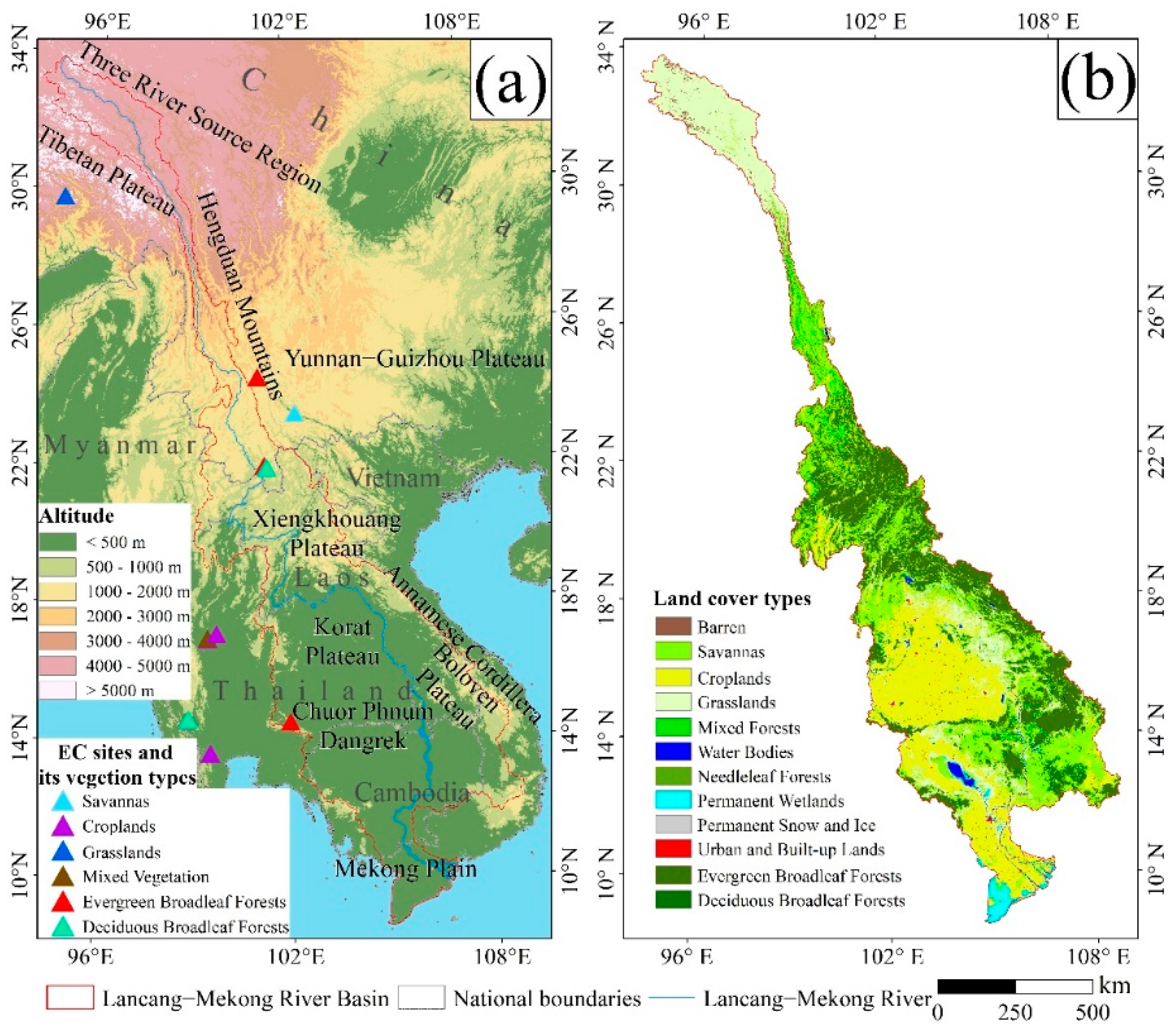
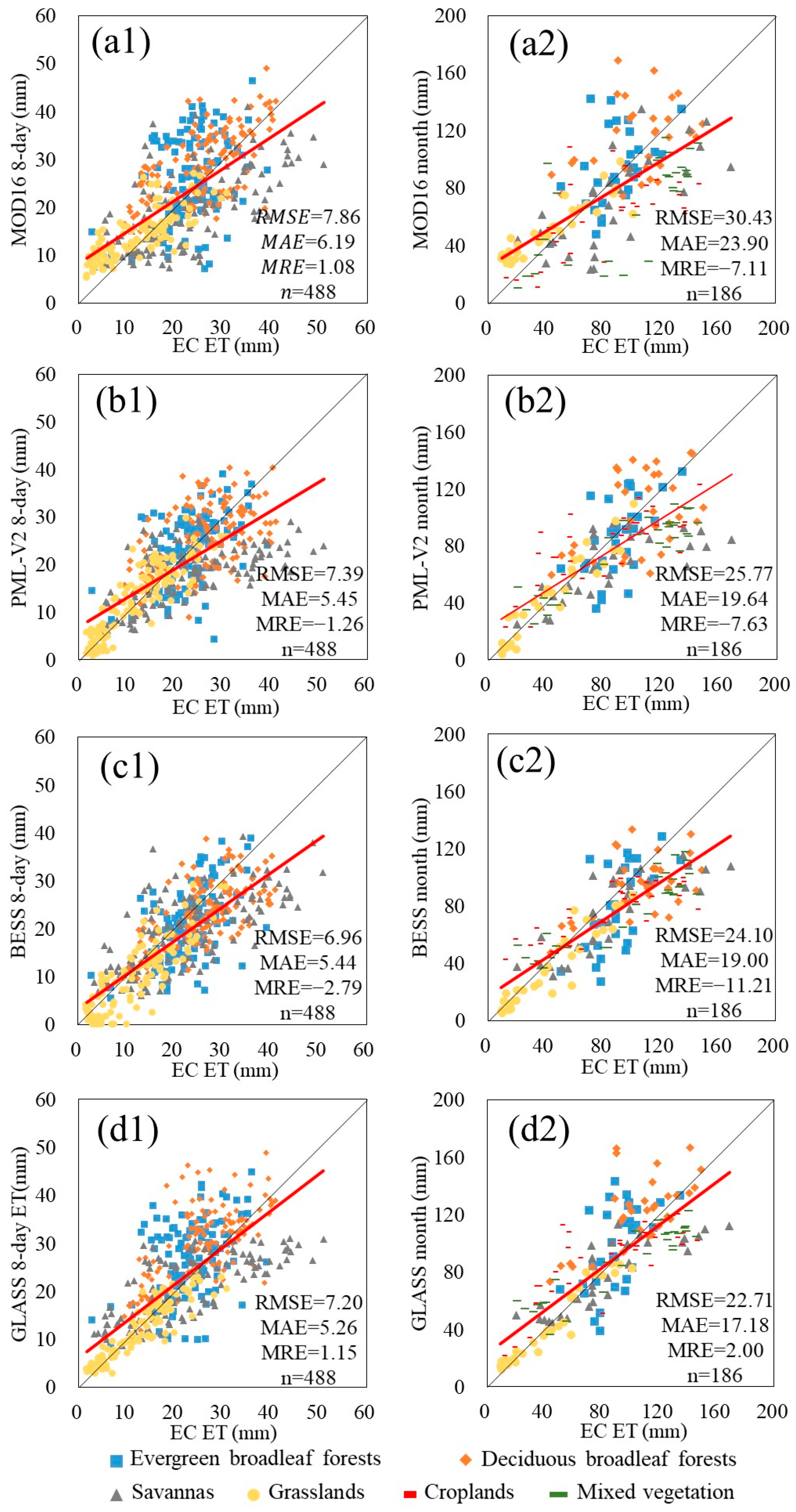
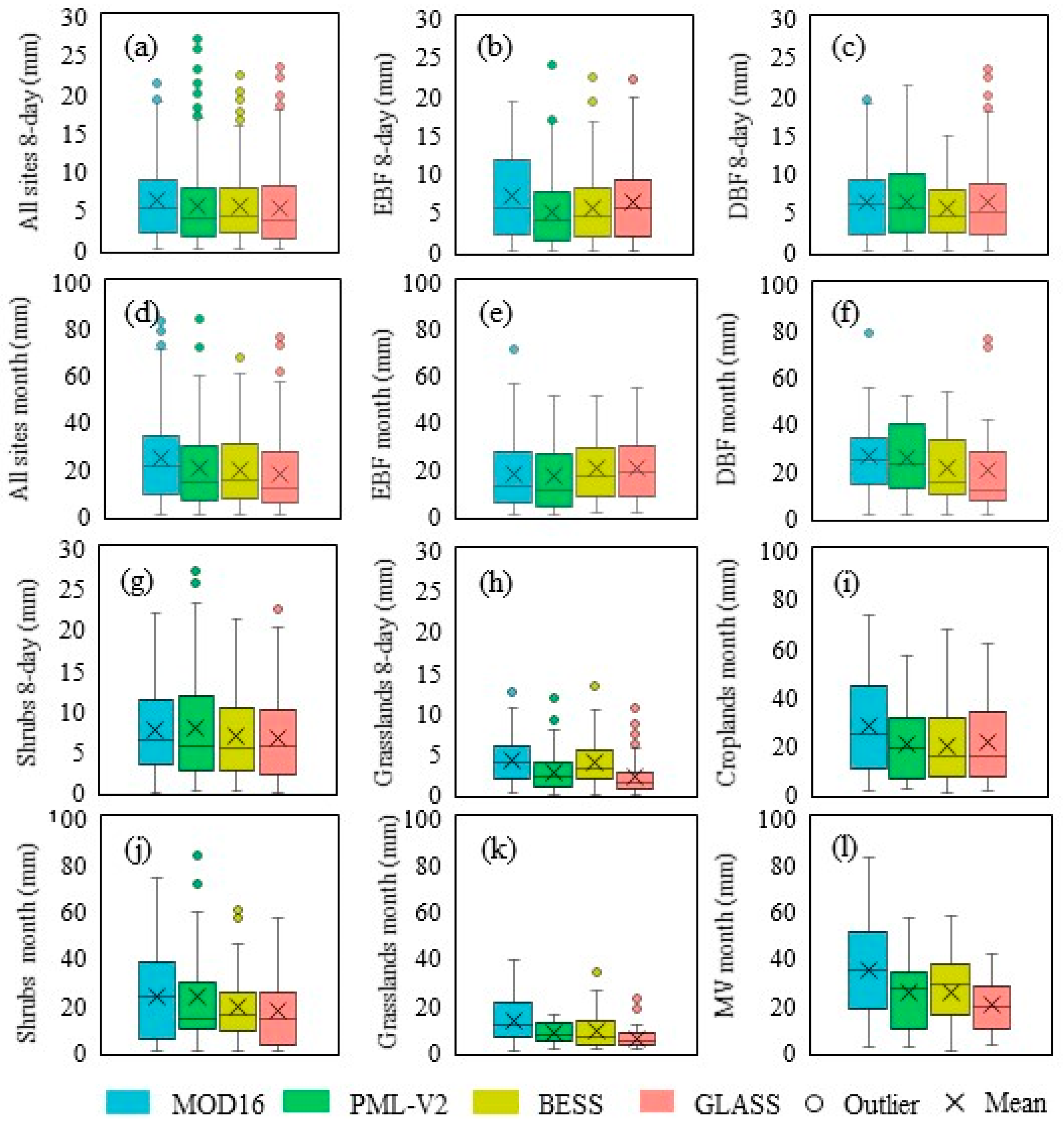
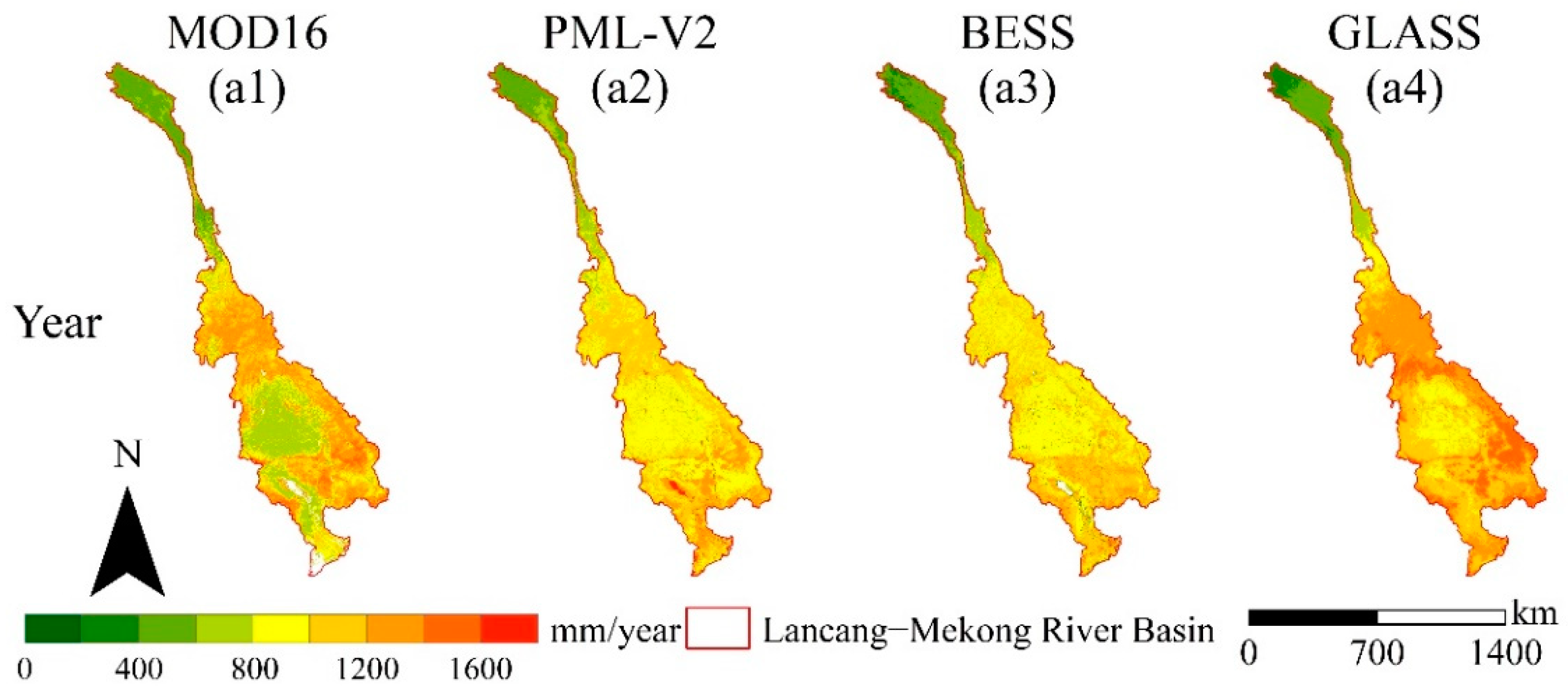
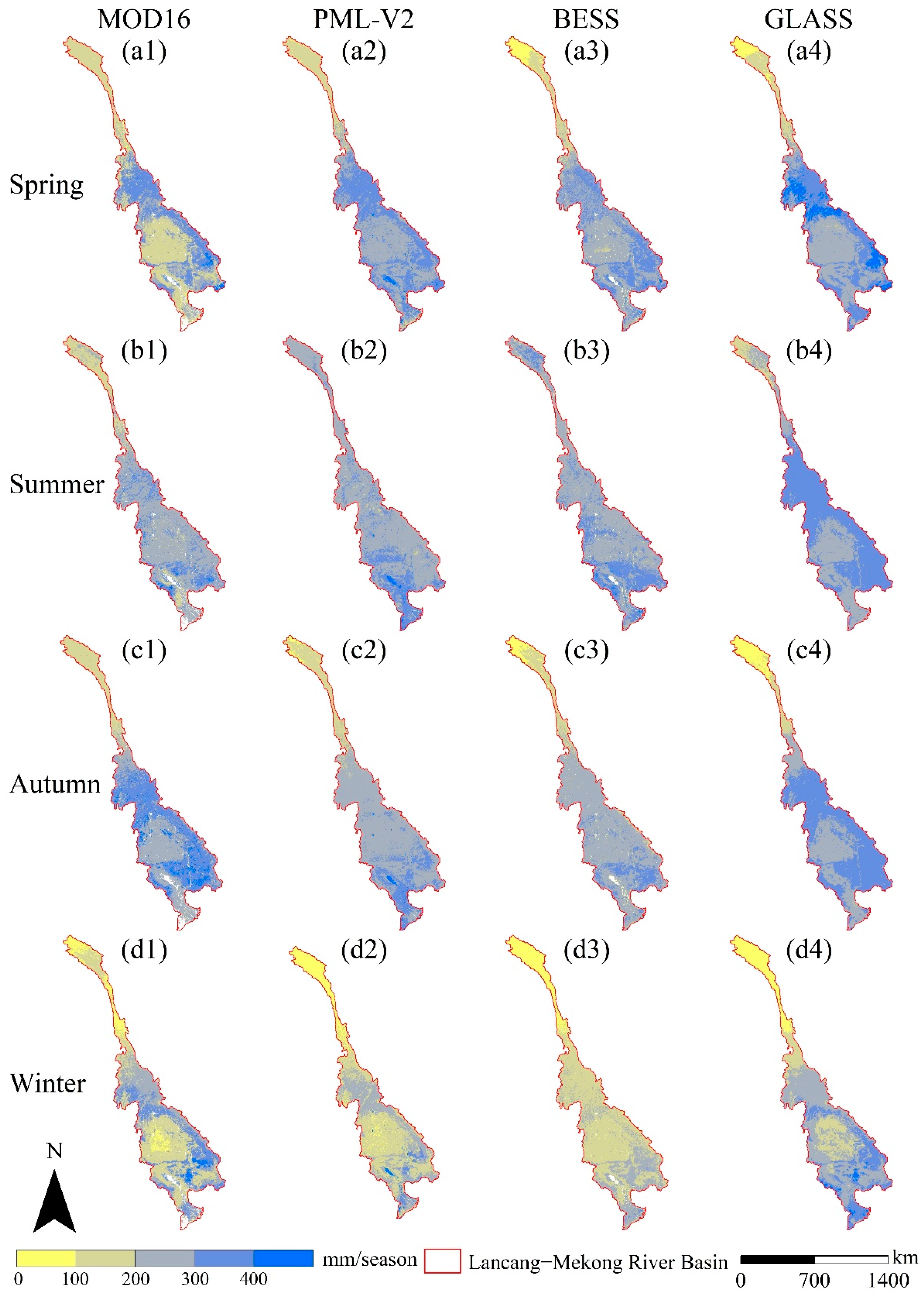
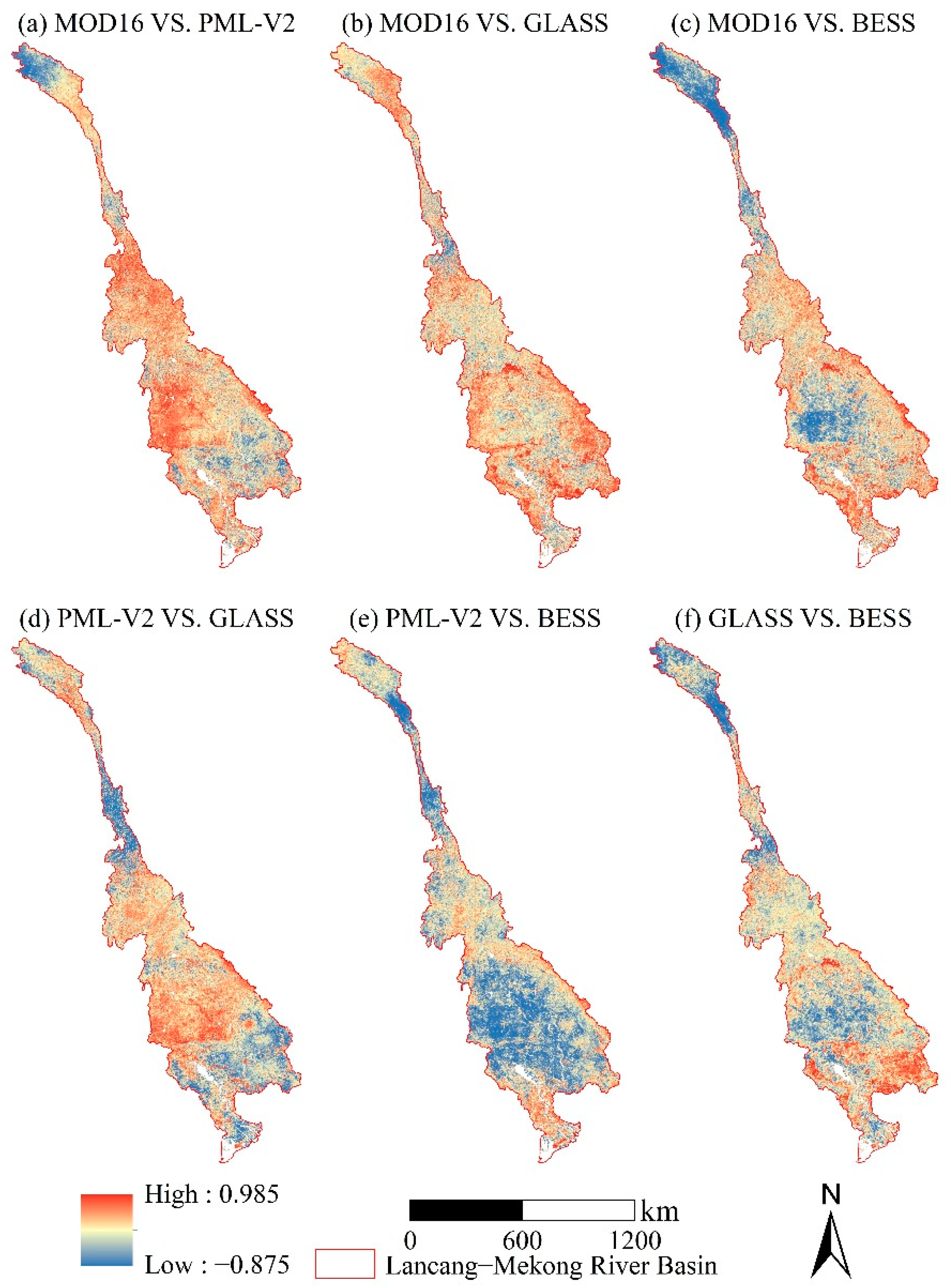
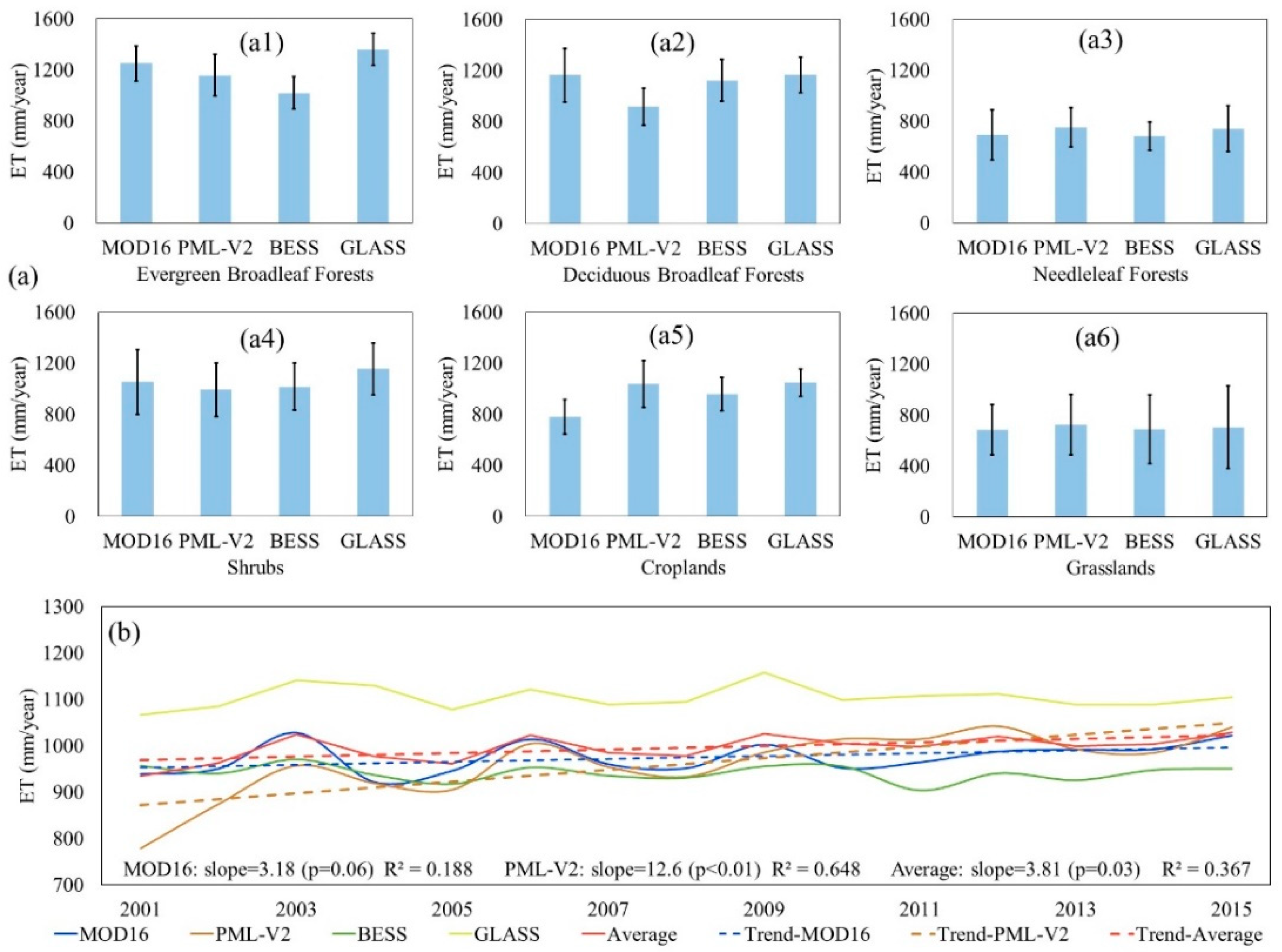
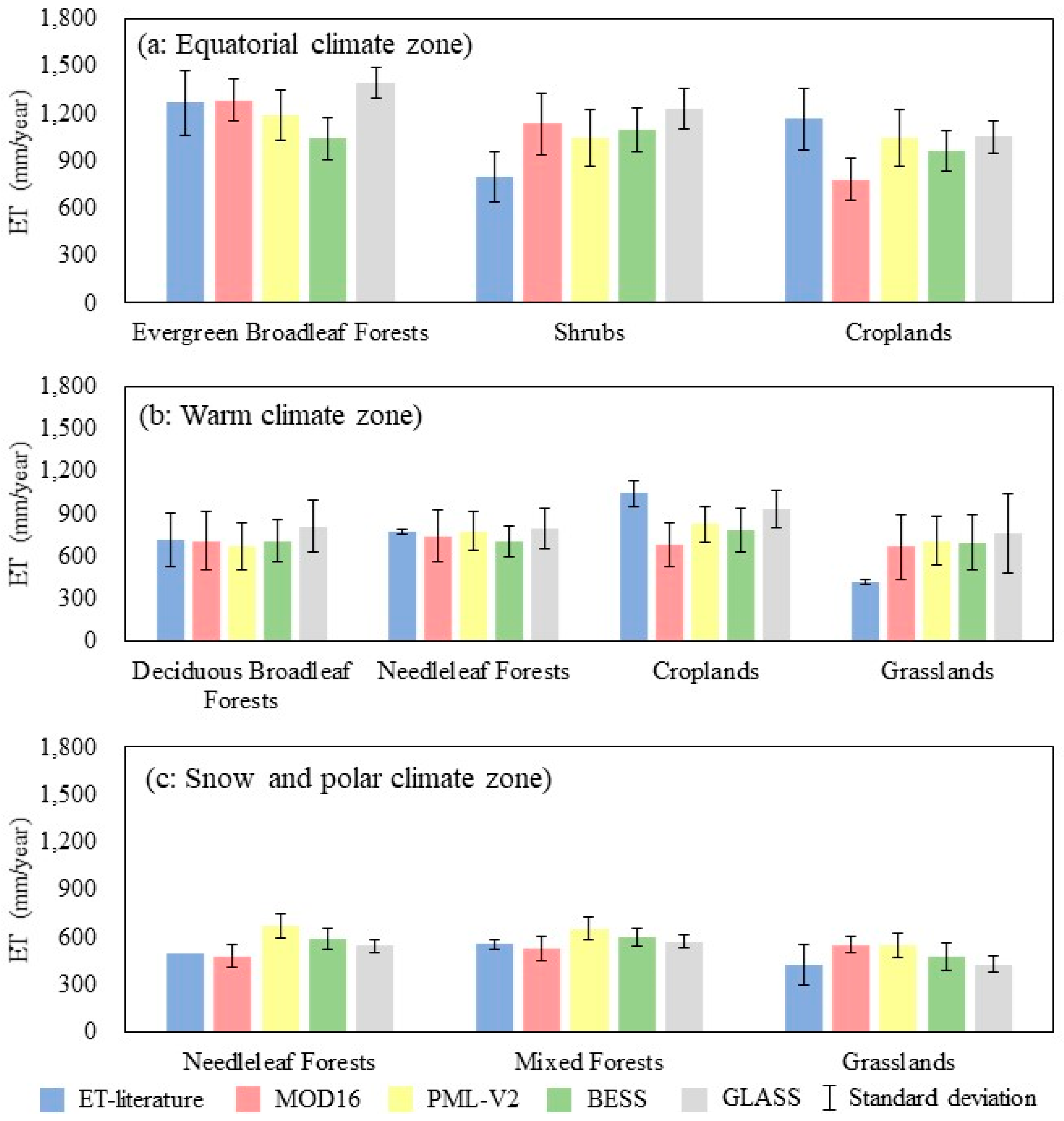
| Land Cover Used in This Study | IGBP Land Cover | Area Ratio |
|---|---|---|
| Evergreen Broadleaf Forests | Evergreen Broadleaf Forests | 24.83% |
| Deciduous Broadleaf Forests | Deciduous Broadleaf Forests | 1.63% |
| Needleleaf Forests | Evergreen Needleleaf Forests | 0.59% |
| Deciduous Needleleaf Forests | 0.00% | |
| Mixed Forests | Mixed Forests | 1.76% |
| Shrubs | Closed Shrublands | 0.01% |
| Open Shrublands | 0.00% | |
| Woody Savannas | 13.31% | |
| Savannas | 12.54% | |
| Grasslands | Grasslands | 17.69% |
| Permanent Wetlands | Permanent Wetlands | 1.51% |
| Croplands | Croplands | 22.49% |
| Cropland/Natural Vegetation Mosaics | 1.90% | |
| Urban and Built-up Lands | Urban and Built-up Lands | 0.40% |
| Permanent Snow and Ice | Permanent Snow and Ice | 0.03% |
| Barren Lands | Barren | 0.52% |
| Water Bodies | Water Bodies | 0.80% |
| Product | Temporal Resolution | Estimation Method | Spatial Resolution | Period | References |
|---|---|---|---|---|---|
| MOD16 | 8-day/year | PM 1 | 500 m | 2000-Present | [11,26] |
| PML-V2 | 8-day/year | PM 1 | 500 m/0.01 | 2000–2020 | [7,9,25] |
| BESS | 8-day/month | PM 1 | 1 km | 2001–2015 | [27] |
| GLASS | 8-day | BMA 2 | 1 km/0.01 | 2000–2018 | [28] |
| Site Name | Latitude (°N) | Longitude (°E) | Elevation (m) | Vegetation Type | Time Span | Source |
|---|---|---|---|---|---|---|
| Yuanjiang | 23.48 | 102.18 | 481 | Shrub | 2013.6–2015.12 | [57] |
| SKR | 14.49 | 101.92 | 543 | EBF 1 | 2002–2003 | ASIAFlux |
| XSBNRa | 21.96 | 101.21 | 750 | EBF | 2003–2016 | [58] |
| Ailaoshan | 24.54 | 101.03 | 2505 | EBF | 2009–2013 | [59] |
| MKL | 14.58 | 98.84 | 231 | DBF 2 | 2003–2004 | ASIAFlux |
| XSBNRu | 21.91 | 101.27 | 580 | DBF | 2010.7–2012.12, 2016 | [60] |
| prt007 | 13.59 | 99.51 | 99 | Cropland | 2011.8–2017.7 | FluxPro |
| ctt007 | 16.90 | 99.43 | 129 | Cropland | 2012.1–2017.9 | FluxPro |
| pst007 | 17.06 | 99.70 | 59 | Cropland | 2004.7–2009.3 | FluxPro |
| dtt030 | 16.94 | 99.43 | 117 | MV 3 | 2003.2–2016.2 | FluxPro |
| QZ-SETORS | 29.77 | 94.74 | 3326 | Grassland | 2008.1–2016.12 | - |
| Vegetation Types | Time Scales | MOD16 vs. PML-V2 | MOD16 vs. GLASS | MOD16 vs. BESS | PML-V2 vs. GLASS | PML-V2 vs. BESS | GLASS vs. BESS |
|---|---|---|---|---|---|---|---|
| All sites | 8-day | 0.112 | 0.019 * | 0.064 | 0.993 | 1.000 | 0.993 |
| Monthly | 0.124 | 0.001 * | 0.034 * | 0.579 | 0.999 | 0.805 | |
| EBF | 8-day | 0.018 * | 0.934 | 0.122 | 0.205 | 0.967 | 0.665 |
| Monthly | 0.726 | 0.553 | 0.574 | 0.346 | 0.362 | 0.975 | |
| DBF | 8-day | 0.714 | 0.987 | 0.307 | 0.701 | 0.165 | 0.315 |
| Monthly | 0.788 | 0.141 | 0.243 | 0.228 | 0.367 | 0.760 | |
| Shrub | 8-day | 1.000 | 0.534 | 0.939 | 0.446 | 0.862 | 0.988 |
| Monthly | 0.954 | 0.148 | 0.303 | 0.164 | 0.331 | 0.673 | |
| Grassland | 8-day | 0 * | 0 * | 0.935 | 0.213 | 0.002 * | 0 * |
| Monthly | 0.031 * | 0.001 * | 0.348 | 0.407 | 0.958 | 0.239 | |
| Cropland | Monthly | 0.097 | 0.116 | 0.071 | 0.927 | 0.881 | 0.809 |
| MV | Monthly | 0.207 | 0.004 * | 0.193 | 0.624 | 1.000 | 0.459 |
| Time Scales | Products | Indicators | All Sites | EBF | DBF | Shrub | Grassland | Cropland | MV |
|---|---|---|---|---|---|---|---|---|---|
| 8-day | MOD16 | RMSE | 7.86 | 7.62 | 7.80 | 9.26 | 4.93 | - | - |
| MAE | 6.19 | 6.05 | 6.44 | 7.56 | 4.10 | - | - | ||
| PML-V2 | RMSE | 7.39 | 6.61 | 7.53 | 10.09 | 3.54 | - | - | |
| MAE | 5.45 | 5.28 | 6.11 | 7.76 | 2.73 | - | - | ||
| BESS | RMSE | 6.96 | 7.02 | 6.49 | 8.74 | 4.36 | - | - | |
| MAE | 5.44 | 5.85 | 5.59 | 6.94 | 3.70 | - | - | ||
| GLASS | RMSE | 7.20 | 7.13 | 7.41 | 8.21 | 3.34 | - | - | |
| MAE | 5.26 | 5.58 | 5.79 | 6.52 | 2.39 | - | - | ||
| Monthly | MOD16 | RMSE | 30.43 | 26.19 | 30.59 | 30.49 | 16.47 | 40.10 | 38.82 |
| MAE | 23.90 | 20.74 | 25.49 | 23.78 | 13.36 | 31.97 | 31.00 | ||
| PML-V2 | RMSE | 25.77 | 22.01 | 25.95 | 32.37 | 10.81 | 25.55 | 27.65 | |
| MAE | 19.64 | 17.48 | 21.71 | 23.51 | 8.63 | 19.92 | 21.47 | ||
| BESS | RMSE | 24.10 | 23.70 | 21.45 | 24.34 | 12.77 | 22.35 | 28.77 | |
| MAE | 19.00 | 19.55 | 18.35 | 18.94 | 10.85 | 19.14 | 22.66 | ||
| GLASS | RMSE | 22.71 | 24.46 | 25.13 | 22.64 | 10.45 | 27.65 | 22.58 | |
| MAE | 17.18 | 18.93 | 19.59 | 16.95 | 7.13 | 22.36 | 18.38 |
| Product Type | MOD16 | PML-V2 | BESS | |
|---|---|---|---|---|
| Meteorological Inputs | , , | , , , | ||
| Remote Sensing Inputs | LAI | MOD15A2 (1 km/8 day) | MCD15A3 (500 m/4 day) | MCD15A2 (1 km/8 day) |
| FPAR | MOD15A2 (1 km/8 day) | - | - | |
| Albedo | MOD43C1_collection5 (0.05°/16 day) | MCD43A3 (500 m/8 day) | MCD43B3 (1 km/16 day) | |
| Albedo QC | - | - | MCD43B2 (1 km/16 day) | |
| Emissivity | - | MOD11A2 (500 m/8 day) | - | |
| LC | MOD12Q1-UMD (1 km/year) | MCD12Q1-IGBP (500 m/year) | MCD12Q1-IGBP (500 m/year) | |
| LST | - | - | MO(Y)D11_L2 (1 km/5 min) | |
| Aerosol | - | - | MO(Y)D04_L2 (10 km/5 min) | |
| Water vapor | - | - | MO(Y)D05_L2 (5 km/5 min) | |
| Cloud | - | - | MO(Y)D06_L2 (1 km or 5 km/5 min) | |
| Atmospheric Profile | - | - | MO(Y)D07_L2 (5 km/5 min) | |
| FCI | - | - | POLDER 3 (6 km/month) | |
| Carbon dioxide concentration | \ | NOAA-GAMSMMD (global/year) | 370 ppm | |
Publisher’s Note: MDPI stays neutral with regard to jurisdictional claims in published maps and institutional affiliations. |
© 2022 by the authors. Licensee MDPI, Basel, Switzerland. This article is an open access article distributed under the terms and conditions of the Creative Commons Attribution (CC BY) license (https://creativecommons.org/licenses/by/4.0/).
Share and Cite
Chen, H.; Gnanamoorthy, P.; Chen, Y.; Mansaray, L.R.; Song, Q.; Liao, K.; Shi, A.; Feng, G.; Sun, C. Assessment and Inter-Comparison of Multi-Source High Spatial Resolution Evapotranspiration Products over Lancang–Mekong River Basin, Southeast Asia. Remote Sens. 2022, 14, 479. https://doi.org/10.3390/rs14030479
Chen H, Gnanamoorthy P, Chen Y, Mansaray LR, Song Q, Liao K, Shi A, Feng G, Sun C. Assessment and Inter-Comparison of Multi-Source High Spatial Resolution Evapotranspiration Products over Lancang–Mekong River Basin, Southeast Asia. Remote Sensing. 2022; 14(3):479. https://doi.org/10.3390/rs14030479
Chicago/Turabian StyleChen, Houbing, Palingamoorthy Gnanamoorthy, Yaoliang Chen, Lamin R. Mansaray, Qinghai Song, Kuo Liao, Aoni Shi, Ganlin Feng, and Chenna Sun. 2022. "Assessment and Inter-Comparison of Multi-Source High Spatial Resolution Evapotranspiration Products over Lancang–Mekong River Basin, Southeast Asia" Remote Sensing 14, no. 3: 479. https://doi.org/10.3390/rs14030479
APA StyleChen, H., Gnanamoorthy, P., Chen, Y., Mansaray, L. R., Song, Q., Liao, K., Shi, A., Feng, G., & Sun, C. (2022). Assessment and Inter-Comparison of Multi-Source High Spatial Resolution Evapotranspiration Products over Lancang–Mekong River Basin, Southeast Asia. Remote Sensing, 14(3), 479. https://doi.org/10.3390/rs14030479





